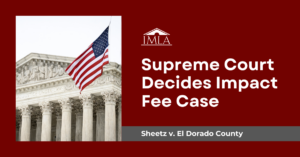12 Apr Supreme Court Decides Impact Fee Case
 Today, in a unanimous opinion, the Supreme Court issued a narrow holding in Sheetz v. El Dorado County, a Takings case involving impact fees. The Court held that legislatively enacted impact fees are not exempt from Nollan and Dolan but remanded to the lower court on all other arguments.
Today, in a unanimous opinion, the Supreme Court issued a narrow holding in Sheetz v. El Dorado County, a Takings case involving impact fees. The Court held that legislatively enacted impact fees are not exempt from Nollan and Dolan but remanded to the lower court on all other arguments.
This case involves the County of El Dorado’s traffic impact mitigation fee, which it adopted via General Plan, to require new development to help finance the construction of new roads and widen existing roads. The amount of the fee is set by formula after the County conducted a nexus study and generally, the fee was based on the location of the project (i.e., the specific geographic zone within the County) and the type of project (e.g., single-family residential, multi-family residential, general commercial). In assessing the fee, the County does not make any “individualized determinations” as to the nature and extent of the traffic impacts caused by a particular project on state and local roads.
Mr. Sheetz, a resident of the County, applied for a building permit to construct a single-family home on his property. The County agreed to issue the permit on the condition that he pay the impact fee. He paid and the permit was issued, but he then challenged the fee as invalid under the Takings Clause of the Fifth Amendment. He argued that the fee was an unconstitutional condition under Nollan and Dolan as the County did not make an individualized determination that an “essential nexus” and “rough proportionality” existed between the traffic impacts caused by his project and the need for improvements to state/local roads.
The California Court of Appeals held that the Nollan and Dolan “essential nexus” and “rough proportionality” tests do not apply to legislative exactions that are generally applicable to a broad class of property owners like the one at issue in this case.
In a 9-0 decision authored by Justice Barrett, the Supreme Court reversed, concluding that “[t]he Takings Clause does not distinguish between legislative and administrative permit conditions.” The Court reasoned that the text, history, and precedent support its conclusion that legislatures are not exempt from the Takings Clause. And because the Takings Clause applies equally to legislators and administrators, it “prohibits legislatures and agencies alike from imposing unconstitutional conditions on land-use permits.”
The Court acknowledged that the area of permit conditions is “complicated.” But, the Court explained, where a building permit is conditioned on something unrelated to the land-use interest Nollan and Dolan will apply. Nollan requires an “essential nexus” between the condition and the government’s land-use interest. While Dolan requires the conditions to have “‘rough proportionality’ to the development’s impact on the land-use interest.”
The Court’s narrow ruling was not entirely surprising after oral argument as it noted that the parties agreed on this bottom line holding as the County conceded at oral argument that “building permits are not exempt from scrutiny under Nollan and Dolan just because a legislature imposed them.” The silver lining was that in reaching this narrow holding, the Court declined to address any other arguments “including whether a permit condition imposed on a class of properties must be tailored with the same degree of specificity as a permit condition that targets a particular development.” In other words, the Court did not rule on Mr. Sheetz’s arguments that Nollan and Dolan require local governments to make individualized determinations regarding the impact fees.
Importantly, the decision does not prevent local governments from enacting reasonable permitting conditions, including impact fees, via legislation. Though local governments will want to ensure that all such legislatively imposed impact fees comply with Nollan and Dolan’s requirements. And local governments may expect challenges by litigants in this area to ensure compliance with the heightened scrutiny required under these precedents.
Although the decision was unanimous, it resulted in three separate concurrences. The main disagreement appeared to be between Justice Gorsuch, who wrote only for himself, and Justice Kavanaugh, who wrote for himself, as well as Justices Kagan and Jackson. Justice Kavanaugh explains that the majority decision does not “address or prohibit the common government practice of imposing permit conditions, such as impact fees, on new developments through reasonable formulas or schedules that assess the impact of classes of development rather than the impact of specific parcels of property.” Justice Gorsuch’s concurrence notes that Nollan and Dolan do not “distinguish[] between government actions against the many and the few.” This issue will warrant further development in the lower courts and local governments will want to ensure they advocate for positions that do not require individualized inquiries into these legislatively enacted fees.
The Local Government Legal Center filed an amicus brief joined by IMLA, NACo, NLC, and GFOA authored by Austin Yang, Kristen Jensen, & Giulia Gualco-Nelson with the City and County of San Francisco. In the brief, the LGLC argued that legislatively enacted, generally applicable impact fees should not be subject to Nollan and Dolan. But more fundamentally, the brief emphasized the importance and ubiquity of legislatively enacted impact fees and stressed that the Court should not require individualized determinations for these fees as doing so would wreak havoc on development. The brief also educated the Court on nexus studies and the importance of impact fees more broadly.
To read the decision, click here.
To read the amicus brief, click here.



